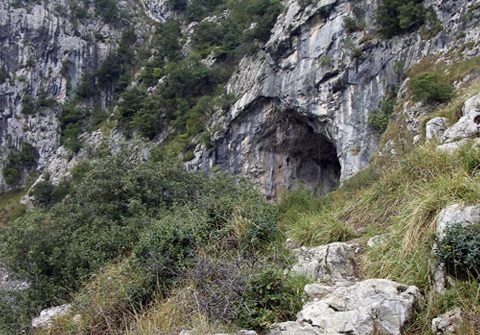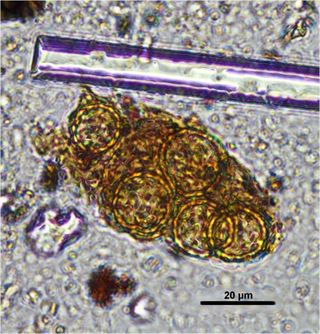Of flowers and burials. The remarkable case of the Red Lady of El Mirón
Authors:
Maria-José Iriarte-Chiapusso is an Ikerbasque research professor at the Department of Geography, Prehistory and Archaeology, University of the Basque Country (UPV/EHU).
Álvaro Arrizabalaga is a lecturer of Prehistory in the University of the Basque Country (UPV/EHU).

Archaeology has been defined as the “Science of Trash”. However fortunate or unfortunate that definition might be, it could be specified even more as the “trash that has survived the passing of time”. Everyday archaeological work leaves little room for speculating or wondering about the significance of the finds, as they are usually restricted (particularly in older periods) to the remains of tools, food and a few structures associated with human action. The interpretation of the finds must be based on a recognition of the negative record. Apart from certain accidental situations, what is not found may be much more significant that what is recorded as most organic substances and many minerals perish relatively quickly.
On rare occasions in the professional life of an archaeologist a small “window of opportunity” opens up, one of those fortunate accidents allowing access in greater depth to aspects of social or economic organisation in the past, or the daily life of a certain individual. Despite the tragedy for the people involved, the eruption of Vesuvius in AD 79 opened a magnificent large window of opportunity without which our knowledge of classic Roman society would not be the same. The discovery and study, since 1973, of the so-called “Vindolanda tablets”, a large ensemble of letters of all kinds written in ink on wooden boards, miraculously preserved in the humid environment of a Roman camp by Hadrian’s Wall, represented another veritable revolution. The further we go back in time, however, such miracles become rarer and virtually disappear.
In the course of the last few weeks, a series of papers from a monographic issue of “Journal of Archaeological Science” has been published digitally. They refer to a human burial dated in the middle Magdalenian (about 16,000 years ago) in Cueva del Mirón (Ramales de la Victoria, Cantabria). Even before this special issue could be completed, the circumstances of this burial were being reported in scientific outreach publications and in the mass media, owing to its special features. Funerary behaviour and, by extension, symbolic behaviour, is extremely vulnerable to the passing of time and only becomes fossilised in very exceptional circumstances. It is easy to calculate the thousands of generations of humans of different species that have preceded us in Europe, in the last 100,000 years alone, of which we only know a handful of clear human burials. One of the determining factors to be able to discriminate between a random find of human remains and a deliberate burial is the funerary treatment, involving actions such as digging a grave, depositing grave goods or manipulating the body in some ritual way. And the case of Cueva del Mirón is a paradigmatic example of such behaviour, in which even flowers were left with the body at the time of its definitive burial.
This is the only Magdalenian burial in the Iberian Peninsula to be found in a stratigraphic context, perhaps the second example we know of such funerary behaviour. An adult woman (between 35 and 40 years of age), of medium height (about 1.60m tall) who presumably died near the cave was buried in a flexed position on her left side. We also know this woman’s diet, which was mixed (meat, fish and vegetables, both terrestrial and marine). A sheltered part of the cave was used for the burial, between a fallen block (displaying engravings dating from the same period) and the cave wall. The most striking aspect is that the grave was covered with stones, sediment, and ochre powder which had apparently been brought from the lower part of the Asón valley (over 25km from the cave). Even more surprisingly, the pollen study of the grave has shown that a number of flowers in the family Chenopodiaceae were left by the body. This human action, which we can identify with perfectly, represents one of the oldest such cases known in the world.

To reach this conclusion 1, it was necessary to follow a quite elaborate procedure. The methodology to isolate and identify fossil pollen grains is well known and today is applied almost universally to archaeological deposits of Palaeolithic age. From the pollen associations found in the sediment, it is possible, in the first place to infer the vegetation around the site at that time and, secondly, by applying the Principle of Actualism, the climate existing at the time of the deposit. The habitation level contemporary with the burial has been documented, like many others of the same chronology in northern Spain. The family of the Chenopodiaceae does not reach significant proportions (over 5% of the fossilised pollen) in any of them, whatever the altitude or position of the site. However, this family accounts for half the pollen grains around the burial, which clearly differentiates it from other contexts.
Once the association between the burial and the over-representation of Chenopodiaceae had been established, other explanations apart from an offering of flowers were considered: the remains of food, medical treatments, and other practical uses. However, the overwhelming dominance of this single family is accompanied by another particular circumstance; the pollen grains are often found clustered together as if the flowers that held them had reached the grave whole. The other three explanations are barely compatible with such a high frequency of pollen but unimaginable in view of the clustering of the grains. Therefore, the most plausible hypothesis is that the flowers were deposited directly, at the time of the burial. However, other reasons apart from strictly ritual ones need to be considered. The plants might have been taken to avoid the bad smell associated with the burial or to sanitise the place in some way.
In any case, if we were to search for the origin of many forms of behaviour that today seem unquestionably symbolic, we would often find that they began for much more practical purposes that became forgotten in the collective unconsciousness. The fact remains that, in our species, although we may never know the real reason for leaving these flowers, this behaviour is inevitably familiar and intimate.
References
- María-José Iriarte-Chiapusso, Alvaro Arrizabalaga, Gloria Cuenca-Bescós (2015) The vegetational and climatic contexts of the Lower Magdalenian human burial in El Mirón Cave (Cantabria, Spain): implications related to human behavior Journal of Archaeological Science DOI: 10.1016/j.jas.2015.02.008